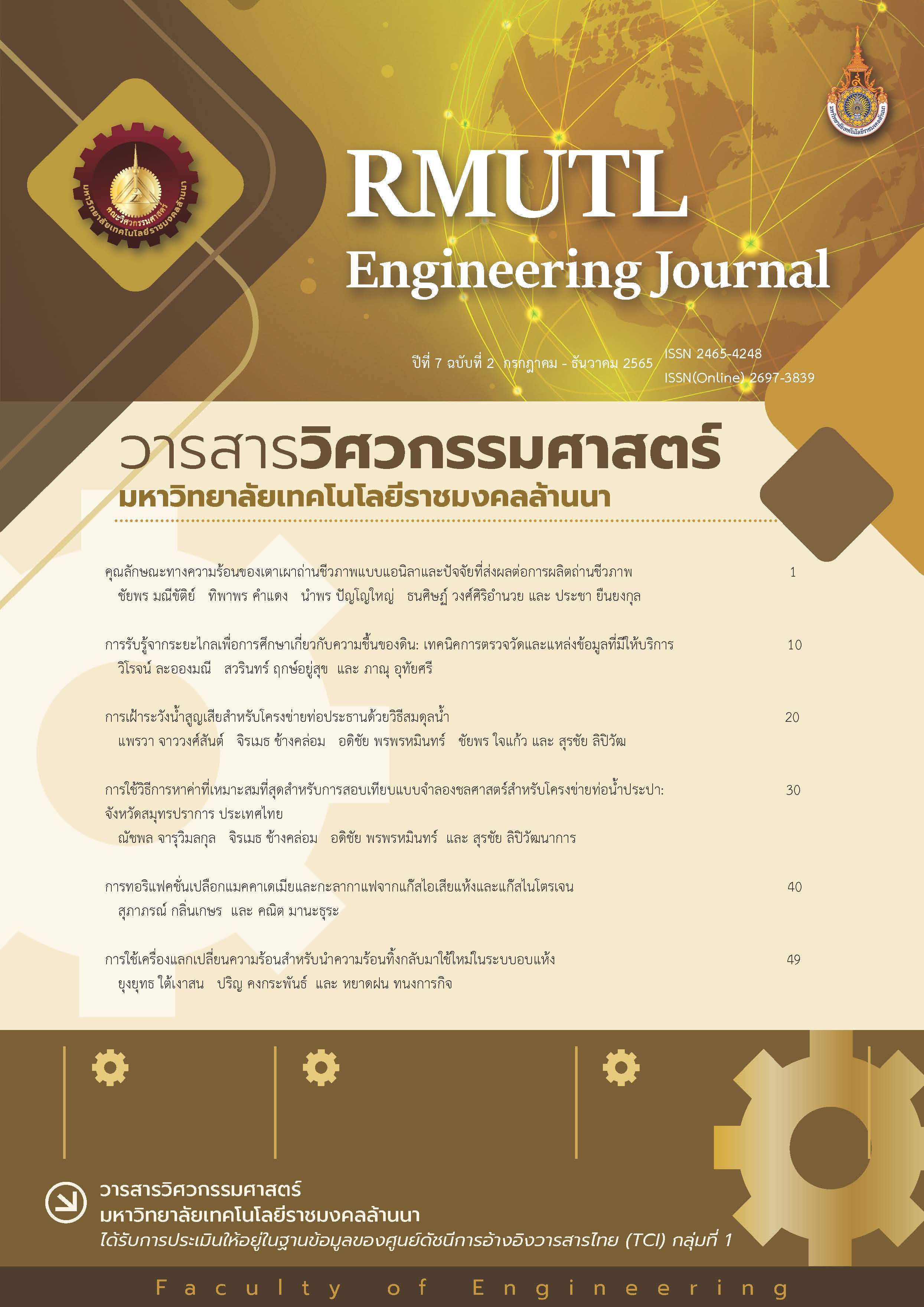Use of a Heat Exchanger for Waste Heat Recovery in Drying System
DOI:
https://doi.org/10.14456/rmutlengj.2022.12Keywords:
Drying, Heat Exchanger, Waste Heat Recovery, Energy Saving, Global WarmingAbstract
The objective of this research is to design, construct, and test a cross-flow heat exchanger to recover waste heat from the drying process in order to increase the dryer efficiency. Inside the heat exchanger, there are 12 pipes with a diameter of 5 cm and a length of 60 cm placed alternately in 5 rows as a channel for the humid air (hot fluid) to be evacuated. The total heat exchange area is 1.13 m2. The heat from humid air is transferred to dry air (cold fluid) that flows through the stacks of pipes, causing the dry air to increase in temperature. The heat exchanger is composed primarily of food-grade stainless steel (SUS304). It is covered by an insulating layer on the outside in order to reduce energy loss. From the heat exchanger test results at the average inlet humid and dry air temperatures of 55 and 36 °C, where both fluids were controlled to have the same mass flow rate of 0.017 kg/s, it was found that the heat exchanger effectiveness and efficiency was 31.58% and 64.81%, respectively. The device warmed dry air to a maximum and average temperature rise of 6.00 and 4.42 °C and reduced humid air to a maximum and average temperature of 10.71 and 6.82 °C, respectively. That equates to 272.40 kJ of recovered energy or 9.16% of the waste heat released. From the results of the kaffir lime leaf drying experiment, it was found that the installation of a heat exchanger did not affect the drying rate. From the results of the kaffir lime leaf drying experiment, it was found that the installation of a heat exchanger did not affect the drying rate, but it reduced the specific energy consumption (SEC) by 9.81% and increased the specific moisture extraction rate (SMER) by 10.88%. That makes the efficiency of the improved dryer higher than the original one of 10.88%. As a result, the energy costs of producing dried kaffir lime leaf were reduced by 9.39%.
References
Energy statistics of Thailand. Energy Policy and Planning Office. Ministry of Energy.
Thailand;2019. Thai.
Energy conservation in thermal system, Bureau of Energy Human Resource Development.Department of Alternative Energy Development and Efficiency. Ministry of Energy.Thai.
Dussadee N. Agricultural products Drying with renewable energy. Basics and Applications. Maejo University Press. Chiang Mai Thailand; 2016. Thai.
Piamdee J. Design and Construction of Heat HEXchanger for Waste Heat Recovery in a Snack Drying Process. MEng thesis. Chiang Mai University Chiang Mai Thailand; 2002. Thai.
Akbari A, Kouravand S, Chegini G. Experimental analysis of a rotary heat exchanger for waste heat recovery from the exhaust gas of dryer. Appl Therm Eng. 2018 Jun;138:668–74.
Kunlawaniteewat J. Heat HEXchanger Network Control Structure Design. MEng thesis.
Chulalongkorn University Bangkok Thailand; 2001. Thai.
Kraitonga K, Nuntaphan A. Application of Cross Flow Heat Exchanger Modified from Automobile Air conditioning Condenser: A Case Study of Waste Heat Recovery from Hot Water for Air Preheating. 2005; 13(1):(1):13–23.
Cengel YA. Heat Transfer. A Practical Approach. 2nd ed Singapore: McGraw - Hill
International Edition; 2003.
Thai Community Product Standard. TCPS 136/2015.Dried Fruits and Vegetables.Thai Industrial Standards Institute. Ministry of Industry Thailand. 2015. Thai.
Sarkar J,Bhattacharyya S,Gopal MR.Transcritical CO 2 Heat Pump Dryer: Part 2. Validation and Simulation Results. Dry Technol. 2006 Dec; 24 (12):1593–600.
Charoenvai SC, Yingyuen W, Jewyee A, Rattanadecho P, Vongpradubchai S. Analysis
of Energy Consumption in a Drying Process of Particleboard Using a Combined Multi-
Feed Microwave-Convective Air and Continuous Belt System (CMCB).Sci Technol Asia. 2013;1-15.
Syahrul S, Dincer I, Hamdullahpur F. Thermodynamic modeling of fluidized bed
drying of moist particles. Int J Therm Sci. 2003 Jul;42(7):691–701.
Downloads
Published
How to Cite
Issue
Section
License
Copyright (c) 2022 RMUTL.Eng.J.

This work is licensed under a Creative Commons Attribution-NonCommercial-NoDerivatives 4.0 International License.










